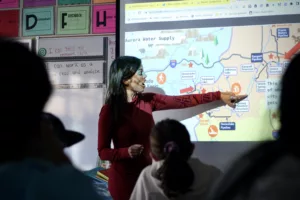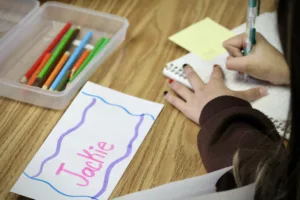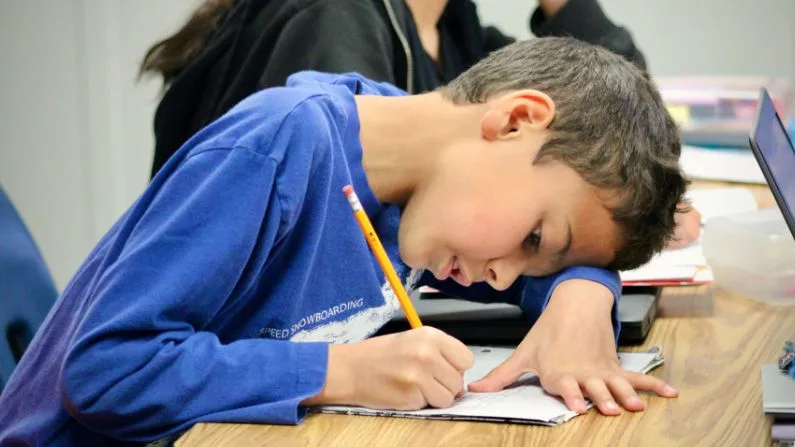Think back to fifth grade. It’s not easy. Those days have a habit of blurring together into a mishmash memory of fractions and recess and two-page essays about the Revolutionary War. But a few special days tend to stick out from the monotony. On a recent February morning, a classroom at Basalt Middle School in Colorado had one of those days.
A special guest was visiting, and she brought lessons about something unusual: water.
Megan Dean, the director of education for the Roaring Fork Conservancy, is helping Basalt fifth graders who live about half an hour from Aspen connect with pen pals in the Denver suburbs on the other side of the state. Dean’s nonprofit focuses on the Roaring Fork River, a tributary to the Colorado River.

Megan Dean, director of education at Roaring Fork Conservancy, teaches students at Basalt Middle School how water flows from Colorado’s mountains to big cities on the eastern side of the continental divide, on Feb. 16, 2023. (Alex Hager / KUNC)
Dean led the class through a few activities to help the kids understand where water comes from, where it goes and how much we use. In one activity, students squeeze spongefuls of water into a bucket. Three wrings of a small dish sponge show how much water is used by people, three wrings of a much bigger one, the kind you’d use to wash a car, show how much is used by farms and ranches.
In another activity, the fifth-graders held their arms up in the air to form a vee, making the shape of a valley and repeating Dean’s lesson that “a watershed is where all the water flows to one place.”
During snack time, over a chorus of crinkling wrappers, Dean explained the mission of the conservancy and described how water flows down from the mountains, past the high-altitude town of Basalt, until it reaches the Colorado River. She showed how through a network of pipes, canals and tunnels the river’s water also reaches the state’s big cities and suburbs where the mountains recede into plains. Dean traced her finger along to a topographic map of Colorado and introduced the “Continental Divide,” the dividing ridge that separates east-flowing water from water that flows west. That divide is a hydrological split, but also an ideological one.

A student at Basalt Middle School squeezes water from a sponge during an activity designed to teach kids about how much water is used by people, farms, and animals, on Feb. 16, 2023. (Alex Hager / KUNC)
In Colorado, roughly 80% of the water falls on the western side of the mountains, but about 80% of the people live on the eastern side. That fact spawned the construction of a massive diversion network starting in the 1930s. Those pipes and tunnels have made some people territorial, arguing — and suing — to keep more water near where it originates. Over decades of debate, uncomfortable realities about how the state’s water is distributed have driven a wedge between rural, agricultural communities and urban ones.
The same story plays out across the rest of the arid West. Nearly 60% of the Colorado River – which flows to 40 million people and a multibillion-dollar agricultural industry,starts in the mountains of Colorado. The river is divided among seven U.S. states, Mexico and 30 federally-recognized Indian tribes. As the river shrinks, those interests are caught in a standoff about how it should be shared, rife with finger-pointing and tense debates about water conservation.
When Basalt fifth-grader Harper French first learned about the east-west split of Colorado’s water and people, his reaction was the same as a lot of adults.

A fifth-grader at Vista Peak Exploratory in Aurora responds to her pen pal in Basalt on March 7, 2023. Students shared their favorite movies and video games as well as their favorite ways of playing with water. (Alex Hager / KUNC)
“They should thank us for sharing the water,” he said during one of Dean’s presentations, “We’re really nice and sharing water, right?”
A handful of other students blurted out in agreement.
The pen pal project is set up to combat that kind of mentality. While adults in the region often get territorial, Dean wants to set the basin’s youngest water users on a more neighborly course.
“They don’t have the ownership of things,” she said of the students. “They’re not stuck in me and mine and what they expect. They’re bright and fresh, and they see the baseline science and knowledge as something that’s very understandable, because they’re not distracted from personal wants.”
Around the room, the kids start to brainstorm what they’ll write to their buddies on the other side of the mountains. It only takes about three and a half hours to drive from Basalt to Aurora, but the differences feel big to these fifth graders. After all, they live in a town of 4,000, mostly known for outstanding fly fishing, and their pen pals live in the state’s third largest city, among sprawling suburbs.
“They live in a giant city and stuff,” French said. “What is it like? We live in a beautiful place. I don’t know if they do, so I’d probably ask them about that.”

A fifth-grader and her plush pal watch as Megan Dean teaches students at Basalt Middle School about the continental divide on Feb. 16, 2023. “My hope is that they’ll become ambassadors for a healthier way to look at water,” Dean said. (Alex Hager / KUNC)
Students chatted around their tables, armed with new knowledge about their town’s proximity to such an important water supply and a few surprises about where it flows after it leaves their backyard.
“I think we’re just lucky to live in the mountains because that’s where all the rivers come from,” opined Josie Lucca.
“I didn’t know that the tunnels were as big as this classroom,” added Daniel Lopez.
A few weeks later, over 100 miles away and about 1,200 feet lower, letters from the Basalt kids finally made it to the class on the other side of the mountains.
In a portable classroom at Vista Peak Exploratory school in Aurora, fifth-grade teacher Kaaryn Child commanded the room with a highly-anticipated announcement.
“I’m going to allow you to open your letters, read them, and then we’re going to talk about how you’re going to respond to them,” she said as the suddenly-hushed class turned its attention toward its teacher. “When I call your name, please come get yours so that you can open yours up.”
One by one, this group of students made their way to the head of the class and retrieved their envelopes, some decorated with bright marker. Tearing open the letters, students found that they have a lot in common with their buddies across the divide.
“My person likes to do water balloon fights with his friends at the pool,” recounted one boy. “And he also says he plays Roblox, Call of Duty, and Fortnite.”
But it’s not hard to notice a few differences between how the two groups use water. Another boy noted that his favorite way to play with water was to run the hose across the trampoline. Meanwhile, Mehlia Moore describes her pen pal’s more river-centric hobbies.
“Mine said that she likes to go rafting,” Moore said. “She likes watering plants with her mom. She likes to watch movies and she loves, loves, loves rafting.”
But at the end of the day, most students remarked at the fact that their water source is a shared one.
“I learned that both of our water comes from the same place,” said Cole Walton, “Which is the snow and the mountains and the streams and the rivers.
Megan Dean, with the Roaring Fork Conservancy, hopes that message is the one that sticks.
“They start looking at their pen pals as somebody that they can become friends with,” she said, “And somebody that they can share experiences with. After learning and sharing experiences, it becomes a little easier to wrap your head around sharing water.”
That collaborative mentality is one that will likely be needed as the West moves into a drier future. Climate change is shrinking the once-mighty river. The nation’s two largest reservoirs are at record lows after more than two decades of warming temperatures and drying conditions, and climate scientists say the supply is unlikely to return to full strength. That leaves the region with the challenge of cutting demand, in spite of growing cities and a steady appetite for fresh produce grown with Colorado River water.
States negotiating the river’s future have struggled to find compromise, even amid dire circumstances. Dean admits that the project is a small start, but represents the kind of attitude shift that could be the key to more sustainable management of the West’s rapidly-dwindling resource.
“My hope is that they’ll become ambassadors for a healthier way to look at water,” she said. “They’ll share that information with their families, they’ll share that information with other people in their life.”
This story is part of ongoing coverage of water in the West, produced by KUNC and supported by the Walton Family Foundation. KUNC is solely responsible for its editorial content.






